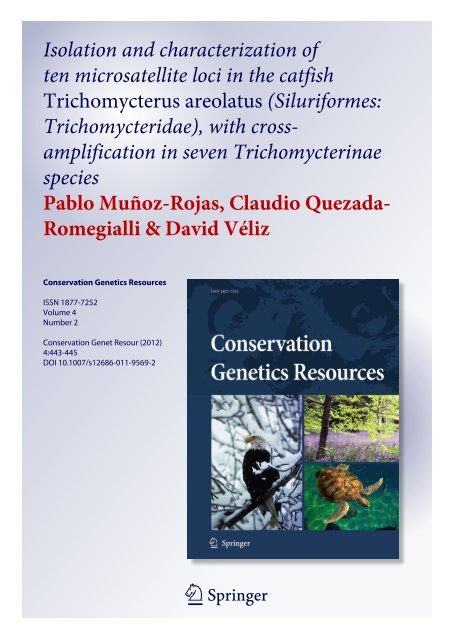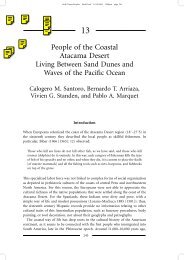Isolation and characterization of ten microsatellite loci in the ... - IEB
Isolation and characterization of ten microsatellite loci in the ... - IEB
Isolation and characterization of ten microsatellite loci in the ... - IEB
Create successful ePaper yourself
Turn your PDF publications into a flip-book with our unique Google optimized e-Paper software.
<strong>Isolation</strong> <strong>and</strong> <strong>characterization</strong> <strong>of</strong><strong>ten</strong> <strong>microsatellite</strong> <strong>loci</strong> <strong>in</strong> <strong>the</strong> catfishTrichomycterus areolatus (Siluriformes:Trichomycteridae), with crossamplification<strong>in</strong> seven Trichomycter<strong>in</strong>aespeciesPablo Muñoz-Rojas, Claudio Quezada-Romegialli & David VélizConservation Genetics ResourcesISSN 1877-7252Volume 4Number 2Conservation Genet Resour (2012)4:443-445DOI 10.1007/s12686-011-9569-21 23
Your article is protected by copyright <strong>and</strong>all rights are held exclusively by Spr<strong>in</strong>gerScience+Bus<strong>in</strong>ess Media B.V.. This e-<strong>of</strong>fpr<strong>in</strong>tis for personal use only <strong>and</strong> shall not be selfarchived<strong>in</strong> electronic repositories. If youwish to self-archive your work, please use <strong>the</strong>accepted author’s version for post<strong>in</strong>g to yourown website or your <strong>in</strong>stitution’s repository.You may fur<strong>the</strong>r deposit <strong>the</strong> accepted author’sversion on a funder’s repository at a funder’srequest, provided it is not made publiclyavailable until 12 months after publication.1 23
Author's personal copyConservation Genet Resour (2012) 4:443–445DOI 10.1007/s12686-011-9569-2TECHNICAL NOTE<strong>Isolation</strong> <strong>and</strong> <strong>characterization</strong> <strong>of</strong> <strong>ten</strong> <strong>microsatellite</strong> <strong>loci</strong><strong>in</strong> <strong>the</strong> catfish Trichomycterus areolatus (Siluriformes:Trichomycteridae), with cross-amplification <strong>in</strong> sevenTrichomycter<strong>in</strong>ae speciesPablo Muñoz-Rojas • Claudio Quezada-Romegialli •David VélizReceived: 28 October 2011 / Accepted: 9 November 2011 / Published onl<strong>in</strong>e: 20 November 2011Ó Spr<strong>in</strong>ger Science+Bus<strong>in</strong>ess Media B.V. 2011Abstract A total <strong>of</strong> <strong>ten</strong> <strong>microsatellite</strong> <strong>loci</strong> were isolated<strong>and</strong> characterized <strong>in</strong> <strong>the</strong> endangered freshwater catfishTrichomycterus areolatus from Chile. Samples from threeseparate watersheds were also analyzed. The mean number<strong>of</strong> alleles per locus <strong>in</strong> a sample <strong>of</strong> 63 <strong>in</strong>dividuals was 4(1–13 alleles per locus) <strong>and</strong> <strong>the</strong> observed heterozygositiesranged from 0 to 0.83. Hardy–We<strong>in</strong>berg equilibrium wasobserved <strong>in</strong> all <strong>loci</strong> except for a few isolated cases, whilenone <strong>of</strong> <strong>the</strong> <strong>loci</strong> exhibited significant l<strong>in</strong>kage disequilibrium.Cross-amplification analysis showed a low number <strong>of</strong><strong>loci</strong> <strong>and</strong> alleles amplified <strong>in</strong> o<strong>the</strong>r seven species <strong>of</strong> <strong>the</strong>Family Trichomycteridae.Keywords Microsatellite markers Population genetics Trichomycterus areolatus Cross-amplificationIntroductionFreshwater fauna are among <strong>the</strong> most threa<strong>ten</strong>ed taxa <strong>of</strong> <strong>the</strong>planet (Ricciardi <strong>and</strong> Rasmussen 1999; Saunders et al.2002). In Chile, 64% <strong>of</strong> <strong>the</strong> freshwater fish are <strong>in</strong> danger <strong>of</strong>ext<strong>in</strong>ction <strong>and</strong> 29% are vulnerable or <strong>in</strong>sufficiently known(Habit et al. 2006; Vila et al. 2006); currently <strong>the</strong>re are feweffective protection measures for <strong>the</strong>se organisms.One <strong>of</strong> <strong>the</strong>se threa<strong>ten</strong>ed species is <strong>the</strong> river catfishTrichomycterus areolatus (Valenciennes 1840), which isP. Muñoz-Rojas C. Quezada-Romegialli D. Véliz (&)Departamento de Ciencias Ecológicas, Facultad de Ciencias,Universidad de Chile, Casilla 653, Santiago, Chilee-mail: dveliz@uchile.clP. Muñoz-Rojas C. Quezada-Romegialli D. VélizInstituto de Ecología y Biodiversidad, Facultad de Ciencias,Universidad <strong>of</strong> Chile, Casilla 653, Santiago, Chilewidely distributed <strong>in</strong> Chile from Huasco (28°27 0 S) toChiloe (42° 32 0 S) (Arratia 1981; Dyer 2000). This specieshas conservation problems, as do all <strong>the</strong> species <strong>of</strong> <strong>the</strong>subfamily Trichomycter<strong>in</strong>ae <strong>in</strong> Chile (Habit et al. 2006;Vila et al. 2006; Quezada-Romegialli et al. 2010).In order to improve <strong>the</strong> plans <strong>of</strong> population conservation,we describe here <strong>the</strong> isolation <strong>and</strong> <strong>characterization</strong> <strong>of</strong><strong>ten</strong> polymorphic <strong>microsatellite</strong> <strong>loci</strong> for <strong>the</strong> Chilean Andeancatfish T. areolatus. Total genomic DNA was extractedfrom ethanol-preserved f<strong>in</strong> clips us<strong>in</strong>g <strong>the</strong> salt-extractionmethod (Aljanabi <strong>and</strong> Mart<strong>in</strong>ez 1997) from samples collectedfrom <strong>the</strong> Limari watershed (Los Aromos: 30° 29 0 S),Choapa watershed (Choapa Pueblo: 31° 45 0 S) <strong>and</strong> Maipowatershed (Estero Puangue: 33° 39 0 S).The library was developed by ATG Genetics (Vancouver,BC, Canada). Template DNA was digested by <strong>the</strong>restriction enzyme HaeIII <strong>and</strong> <strong>the</strong> <strong>microsatellite</strong> enrichmentby biot<strong>in</strong> capture <strong>of</strong> d<strong>in</strong>ucleotide (TC n <strong>and</strong> GA n )<strong>microsatellite</strong>s. The first 36 plasmid clones conta<strong>in</strong><strong>in</strong>g ad<strong>in</strong>ucleotide motif were purified <strong>and</strong> amplified by PCR.Seventeen primer pairs were designed us<strong>in</strong>g Primer5 <strong>and</strong>tested <strong>in</strong> our laboratory, <strong>of</strong> which <strong>ten</strong> gave reliableamplifications <strong>and</strong> polymorphic markers us<strong>in</strong>g agarose gelelectrophoresis. In order to evaluate polymorphism <strong>in</strong> anautomatic sequencer, reverse primers <strong>of</strong> each <strong>microsatellite</strong>were marked with a fluorescent dye.Polymerase cha<strong>in</strong> reaction (PCR) amplification mixtures(12 lL) conta<strong>in</strong>ed 100 ng template DNA, 0.25 lM <strong>of</strong>eachprimer, 100 lM <strong>of</strong> each dNTP, 2 mM MgCl 2 . 1.25 lL10 9 PCR buffer <strong>and</strong> 0.5 U Taq plat<strong>in</strong>um Polymerase(Invitrogen). Cycl<strong>in</strong>g conditions consisted <strong>of</strong> an <strong>in</strong>itial denatur<strong>in</strong>gstep <strong>of</strong> 3 m<strong>in</strong> at 95°C, followed by 35 cycles <strong>of</strong> 30 s at95°C, 30 s at <strong>the</strong> specific temperature, 1 m<strong>in</strong> 30 s at 72°C, <strong>and</strong>a f<strong>in</strong>al elongation step at 72°C for 5 m<strong>in</strong>. PCR products weregenotyped <strong>in</strong> Macrogen Inc (http://www.macrogen.com)123
Author's personal copy444 Conservation Genet Resour (2012) 4:443–445Table 1 Primer sequences <strong>and</strong> characteristics for <strong>ten</strong> <strong>microsatellite</strong> <strong>loci</strong> for Trichomycterus areolatus, <strong>in</strong>clud<strong>in</strong>g <strong>the</strong>ir polymorphism <strong>in</strong> threepopulations (LA, Los Aromos 30° 29 0 S–71° 06 0 W; CC, Choapa 31° 45 0 S–70°40 0 W; PU, Puangue 33° 39 0 S–71° 20 0 W)Locus Primer sequence (5 0 –3 0 ) RepeatmotifTm (°C)GenBankaccessionno.Sample N Ho/He N A Sizerange(bp)Taredi1 F: GAATTCTGAGTGCAGAGCTCT (CA) 9 55 JN167505 LA 23 – 1 126R: CATACCAGCTGTGAAATTCATACA CC 21 – 1 126PU 12 0.25/0.3 4 122–138Taredi4 F: TTTTGAAACCGTCGCTGGAC (GT) 18 55 JN167506 LA 17 0.41/0.47 2 281–283R: CTGTCCTCAGGCTCTTTAC CC – – – –PU 6 083/0.81 7 273–293Taredi6 F: TTTTCAGCTCACCACAATGC (TG) 12 55 JN167507 LA 22 – 1 192R: GCTGCGTCACATGGTGTTAT CC – – – –PU 4 0/0.63 3 192–195Taredi10 F: CCGTGTTGTTTATTCGAGCTC (CA) 9 55 JN167508 LA 21 048/0.49 2 141–155R: GCAGTTATCAGCTGAACCAG CC 21 0.48/0.47 2 141–155PU 14 0.29/ 13 141–1670.91*Taredi11 F: CGAGAGCGAGATCGTGTGTA (CA) 12 55 JN167509 LA 22 0.36/0.46 2 191–201R: TCATAAATCAACGATGCGTCA CC 22 0.59/0.54 3 191–201PU – – – –Taredi14 F: TCTTACAGTATTTAACATCCTGG (CA) 34 50 JN167510 LA 19 0.63/0.62 6 187–207R: GAATTCAGTTCAGCTTTATTCAC CC 20 0.3/0.81* 8 173–207PU 12 0.67/0.84 8 131–163Taredi17 F: CATAAACTGTGTATGTGTGTCA (GT) 13 55 JN167511 LA 23 – 1 110R: GGGGTTCGTTTTCAGAACTG CC – – – –PU 12 0/0.38* 2 110–112Taredi21 F: AACCACAAGGTTTGAGCGTC (AC) 13 55 JN167512 LA 22 0.64/0.69 4 261–275R: AACACTGCTGCATAGACCAG CC 13 0.69/0.62 4 261–275PU – – –Taredi212 F: GGTCTGGAATAAAAATTACAAACACA (GA) 17 55 JN167513 LA 24 0.63/0.65 3 210–221R: ACCGAACAGGTGTCACCATC CC 24 0.5/0.52 3 210–226PU 10 0.4/0.86* 9 225–259Taredi24 F: CCAAGTGGAGCTGCTAGAAA (GT) 20 (CA) 9 55 JN167514 LA 23 0.48/0.41 2 213–214R: CTGCACGCTCCTTTTCCAAA CC 24 0.75/0.49 2 213–214PU 8 0/0.22 2 193–195Tm anneal<strong>in</strong>g temperature, N number <strong>of</strong> analyzed <strong>in</strong>dividuals, NA number <strong>of</strong> alleles; * P \ 0.01 for significant departures from HWE, testedafter 3,000 permutation <strong>in</strong> Genetix (Belkhir et al. 1996)us<strong>in</strong>g <strong>the</strong> <strong>in</strong>ternal size st<strong>and</strong>ard LIZ 500 (Applied Biosystems).Clone sequences were published <strong>in</strong> Genbank with <strong>the</strong>follow<strong>in</strong>g accession numbers: JN167505 to JN167514(Table 1).In <strong>the</strong> 63 <strong>in</strong>dividuals from three geographically isolatedwatersheds <strong>of</strong> <strong>the</strong> central zone <strong>of</strong> Chile we observedbetween 1 <strong>and</strong> 13 alleles per locus (Table 1); some alleleswere found <strong>in</strong> all three watersheds. The Los Aromos site(LA, Limarí watershed) had <strong>the</strong> least allele diversity (1–6alleles per locus), while Choapa (CC, Choapa watershed)had from one to 8 alleles per locus <strong>and</strong> Puangue (PU,Puangue watershed) presented <strong>the</strong> greatest allele richness(1–13 alleles/locus) (Table 2).Deviations from Hardy–We<strong>in</strong>berg expectations (HWE)were calculated us<strong>in</strong>g <strong>the</strong> permutation test associated with<strong>the</strong> F IS calculation performed with GENETIX s<strong>of</strong>tware(Belkhir et al. 1996). Significant deviations from HWE wereobserved only <strong>in</strong> three out <strong>of</strong> <strong>ten</strong> <strong>loci</strong> <strong>in</strong> <strong>the</strong> Puangue River(Taredi10, Taredi17 <strong>and</strong> Taredi212) <strong>and</strong> one from Choapa(Taredi14). MICROCHECKER s<strong>of</strong>tware (Oosterhout et al.2004) was used to identify genotyp<strong>in</strong>g errors due to nullalleles, large allele dropout <strong>and</strong> scor<strong>in</strong>g <strong>of</strong> stutter peaks. Theanalyses suggested that null alleles may be present <strong>in</strong> three<strong>loci</strong> <strong>in</strong> Puangue (Taredi10, Taredi17 <strong>and</strong> Taredi 212) <strong>and</strong> onelocus from Choapa (Taredi14). Fur<strong>the</strong>rmore, no significantl<strong>in</strong>kage disequilibrium was detected among pairs <strong>of</strong> <strong>the</strong>123
















